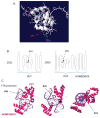The epilepsy phenotypic spectrum associated with a recurrent CUX2 variant
- PMID: 29630738
- PMCID: PMC6021218
- DOI: 10.1002/ana.25222
The epilepsy phenotypic spectrum associated with a recurrent CUX2 variant
Abstract
Objective: Cut homeodomain transcription factor CUX2 plays an important role in dendrite branching, spine development, and synapse formation in layer II to III neurons of the cerebral cortex. We identify a recurrent de novo CUX2 p.Glu590Lys as a novel genetic cause for developmental and epileptic encephalopathy (DEE).
Methods: The de novo p.Glu590Lys variant was identified by whole-exome sequencing (n = 5) or targeted gene panel (n = 4). We performed electroclinical and imaging phenotyping on all patients.
Results: The cohort comprised 7 males and 2 females. Mean age at study was 13 years (0.5-21.0). Median age at seizure onset was 6 months (2 months to 9 years). Seizure types at onset were myoclonic, atypical absence with myoclonic components, and focal seizures. Epileptiform activity on electroencephalogram was seen in 8 cases: generalized polyspike-wave (6) or multifocal discharges (2). Seizures were drug resistant in 7 or controlled with valproate (2). Six patients had a DEE: myoclonic DEE (3), Lennox-Gastaut syndrome (2), and West syndrome (1). Two had a static encephalopathy and genetic generalized epilepsy, including absence epilepsy in 1. One infant had multifocal epilepsy. Eight had severe cognitive impairment, with autistic features in 6. The p.Glu590Lys variant affects a highly conserved glutamine residue in the CUT domain predicted to interfere with CUX2 binding to DNA targets during neuronal development.
Interpretation: Patients with CUX2 p.Glu590Lys display a distinctive phenotypic spectrum, which is predominantly generalized epilepsy, with infantile-onset myoclonic DEE at the severe end and generalized epilepsy with severe static developmental encephalopathy at the milder end of the spectrum. Ann Neurol 2018;83:926-934.
© 2018 American Neurological Association.
Conflict of interest statement
Nothing to report.
Figures


References
-
- Scheffer IE. A new classification and class 1 evidence transform clinical practice in epilepsy. Lancet Neurol. 2017 Jan;17(1):7–8. - PubMed
-
- Lesca G, Rudolf G, Labalme A, et al. Epileptic encephalopathies of the Landau-Kleffner and continuous spike and waves during slow-wave sleep types: genomic dissection makes the link with autism. Epilepsia. 2012;53(9):1526–38. - PubMed
-
- Rauch A, Wieczorek D, Graf E, et al. Range of genetic mutations associated with severe non-syndromic sporadic intellectual disability: an exome sequencing study. Lancet. 2012 - PubMed
Publication types
MeSH terms
Substances
Grants and funding
LinkOut - more resources
Full Text Sources
Other Literature Sources
Medical
Molecular Biology Databases

